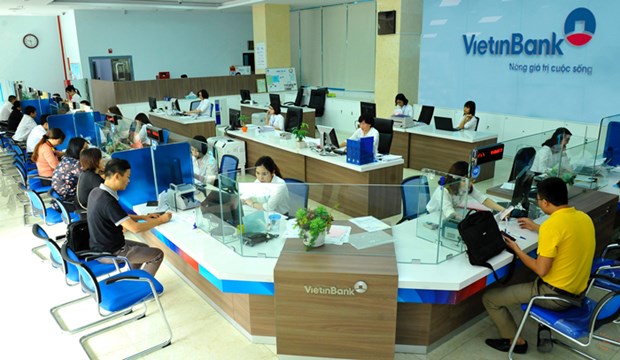 Business Beat
Business Beat


|
| A view of VietinBank’s transaction office in Hà Nội. VietinBank last month announced it completed a bond buyback before maturity worth VNĐ800 billion. VNA/VNS Photo |
HÀ NỘI — Many banks have been stepping up bond buybacks before maturity, but experts are concerned the work can affect the banks’ ability to supply capital for the economy and boost credit growth in the remaining months of this year.
According to the latest bond market report of the second quarter of 2023 issued recently by VNDirect Securities Company, the buybacks of corporate debt securities increased again and a large amount of bonds were repurchased by banks before maturity.
Specifically, in the second quarter of 2023, nearly VNĐ62.54 trillion of bonds were bought back in advance, up 76.8 per cent compared to the first quarter of 2023 and 4.9 per cent over the same period last year. In which, banks bought back 63.7 per cent of the total value, equivalent to VNĐ39.84 trillion.
Data from the Vietnam Bond Market Association (VBMA) also showed banks bought back more than VNĐ17 trillion worth of bonds in May alone, accounting for 66 per cent of the total value of bonds bought back, at nearly VNĐ25.6 trillion.
Most of the bonds repurchased before maturity by banks came with a long term of three years and fall due in 2024 or 2025.
VNDirect's analysts said the main motivation for banks to buy back bonds before maturity was low credit demand, sharply dropping deposit interest rates and abundant liquidity of the banking system in the first months of this year.
With credit growing by a modest 3.13 per cent as of June 20 this year, the lowest level in the past ten years, banks found themselves sitting on mountains of cash. In an attempt to reduce capital redundancy and optimise capital efficiency, banks had little choice but to buy back bonds. As the demand for loans in the economy remained woefully low, banks used their excess money to step up bond buybacks.
The buybacks of bonds that have yet to fall due was seen as a suitable strategy in the first months of this year. However, for the remaining months of this year, experts are concerned that the buybacks of long-term bonds, if continued, will adversely affect the banks’ ability to supply capital for production and business, and boost their lending.
Experts explained that many forecasts show credit demand will be stronger in the second half of this year due to the recovery of the economy. Banks therefore need to have enough capital to meet loan demands of firms and individuals.
Notably, according to Dr. Phùng Thái Minh Trang, head of the Hoa Sen University’s Finance and Banking Faculty, when lending, banks must ensure the ratio of short-term capital, which is allowed to use for medium and long-term loans, as regulated by the State Bank of Vietnam (SBV). Meanwhile, according to a new SBV regulation, from October 1 this year, the ratio will be reduced from 34 per cent to 30 per cent.
The strengthening of long-term bond buybacks before maturity of banks can reduce their medium- and long-term capital, which will cause the ratio of short-term capital used for medium- and long-term loans to increase and fail to meet the SBV’s regulation. Banks, therefore, will have to reduce their lending.
For the above reasons, Trang said, credit growth may be affected by the banks’ bond buybacks.
However, Trang expected the adverse impacts of the bond buybacks could be reduced thanks to the rising value of savings at banks. According to the SBV’s data, since the beginning of the year, the value of deposits raised by banks reached more than VNĐ12.69 quadrillion, some VNĐ268 trillion higher than outstanding loans. The rise of savings has helped the deposit growth rate to gradually catch up with the credit growth rate.
In addition, Trang said, about 88 per cent of deposits in the banking system have short terms of less than 12 months. Therefore, the recovery of this capital indicator can also help to reduce the impact of the bond buybacks.
Although the short-term capital ratio used for medium- and long-term loans at banks is expected not to change much, Trang recommended that banks themselves should prepare measures to ensure the harmony between safety and profit goals when the SBV’s new regulation, which is aimed to minimise liquidity risks for banks, takes effect from October 2023.
In April this year, the SBV issued Circular 03/2023/TT-NHNN to suspend the implementation of Clause 11, Article 4, Circular 16/2021/TT-NHNN, which pertains to the purchase and sale of corporate bonds by local banks and foreign bank branches.
During Circular 03’s validity from April 24 to December 31 this year, banks can buy back the unlisted corporate bonds they previously sold, subject to specific conditions outlined in the circular. They can also repurchase their own bonds if all conditions are met and an agreement with bondholders is reached, or there is a provision for buyback in earlier regulations.
Despite the difficulties faced by the corporate bond market, certain banks still plan to raise capital through this market. For example, Vietcombank recently approved plans to issue bonds to the public in two batches with a total value of VNĐ9 trillion. As banks have continued to exhibit consistent performance, investors are confident in purchasing their bonds, which offer higher interest than savings accounts. — VNS




